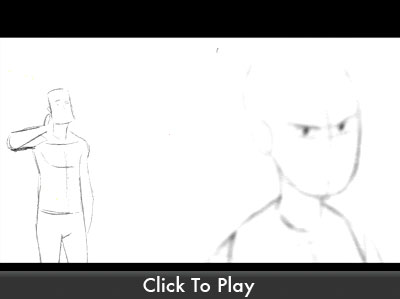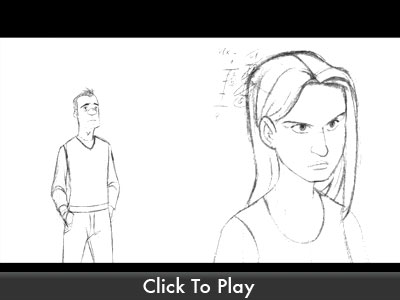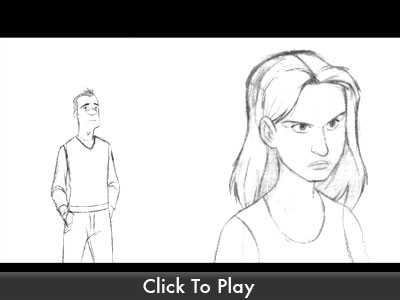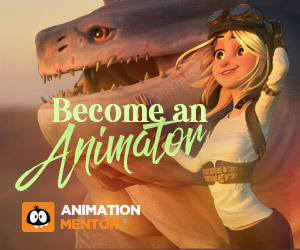Alexander Petreski
Interview conducted by Eric Scheur
What a way to start the new year! The January 2009 competition had some incredibly strong entries, and it was clear that every animator had a lot of fun bringing these two characters to life. It's almost as if when the subject turns of relationships, relationships-gone-bad in particular, suddenly many of us find ourselves on familiar ground to explore. Perhaps this could be a new branch for pop psychologists--animation therapy, anyone?
Well, I don't know if Alexander Petreski was working from any dark memories in his past, but his talent and effort combined to place him in the top spot of everyone who voted in January. With his hand-drawn entry he has given us a scene of shocked anger and cavalier cowardice, and manages to bring us fully into these characters' emotions. What's more, when you talk to Alex about animation, his enthusiasm for the medium and for the art of visual storytelling itself is readily apparent. It was a joy to discover his background, to hear him examine some of his favorite movies, and to learn his thoughts on what it takes to really learn animation in a way that will allow it to sink into your bones.
Congratulations again to Alex and to everyone who entered the January competition. I look forward to seeing more and more of your entries all year long!
- Eric
Hi Alex. You live in Cologne, Germany at the moment--what is the animation community like there?
Well, I [attended] a film school in Cologne (2002) which offered a one-year-program in animation. Since we were the first class in this program everything was kind of chaotic. I say right away you didn’t come out as a good animator, because we were trained only 7 weeks in character animation; the rest was learning Storyboarding, Designing, Producing, Layout, Background, etc. And also doing a short movie somewhere in between. So you can call it more of a crash course of every aspect in the industry. It was good for people who started in this buisness without knowing for sure if they want to become, for example, a character designer or a layout artist. Fortunately, I did a 6-month traineeship in a small studio before, so I was kind of prepared and already knew some of the exercises like the Bouncing Ball, etc.
Anyway, this workshop doesn’t exist anymore. The school cancelled it after the 4th year. The reason for that was mainly because of the lack of work for an animator in Germany. But I know several people who attended the Animation School in Hamburg, which is quite similar to that program. It also goes a year and they even have the same freelance teachers as far as I know.
I never worked for a big studio in Germany (the few that are left), so I can’t say anything about that. In general I would say 2D animation is only done here for commercials, TV specials, or TV series, and very often for pre-production. Animation is usually outsourced to cheaper countries.
Which came first for you: animation or learning to draw?
I started drawing when I was 4. I had talent but never nurtured it, I just did it for fun. I started to think about it seriously when I was 18, I think. So I wasted a lot of time, which I could have spent in learning anatomy or animal structure, etc. So my first idea was to become a comic artist. But I wanted to study, to get my fundamentals right. In order to study I had to do a 6-month traineeship. I ended up somehow in an animation studio and animation got my attention slowly. After these 6 months I didn’t want to study design anymore, I got infected.
How long have you been animating?
Including the time while I attended that animation school it must be roughly 7 years now.
What has your learning process been like?
Oh boy, that’s gonna be a longer story!
During that traineeship I had a lot of fun in discovering animation for myself. Since I was only doing what I wanted, there were no rules or restrictions and most of the time [I did] straight-ahead animations. I think the problems began after I finished the animation school, because my head was now full of rules and principles and that kind of ruined my animation style. Because I was only thinking in terms of anticipation, counter-action, etc. My animation didn’t come out of my heart anymore, instead it came out of my head (some say the left side of the brain). It lacked the spontaneity and raw character my animation used to have when I was a rookie.
After school I started as an assistant in the same studio I left as a trainee. And in my opinion, assisting is one of those things you should do before becoming an animator, there are many reasons for that:
I worked my way up from assistant, to FX animator, to animator for side-characters, and finally character animator. But I still wasn’t happy with my animation. I had the feeling that my artistic development didn’t progress, and I slowly accepted the fact that I was a mediocre animator, so years passed and the only time I drew was during work.
The thing that changed me overnight was an exhibition of Andreas Deja’s animation work in his home town in Dienslaken. Some friends dragged me to come with them and I just had nothing else to do so I agreed. I knew most of the drawings and artwork through art books, the internet or "making of" DVDs, and I wouldn’t say that his work influenced me as an animator. But believe me, if you see it for real, it’s just fascinating. I never expierenced before this power of a single sheet of paper. On that same night when I got home (dizzy from inspiration) I didn’t want to accept that my drawing and animation was only “okay.” I started to do something that I should have done earlier: animate and draw in my free time.
I know it sounds sad, but there is a time where you should think about animation only (only if you don’t have a girlfriend at the moment). In order to be good at something you have to do it intensely over and over and over, from dawn till dusk. And don’t analyze only animated movies, because they are already interpretations and impressions of reality, and if that is your only source of inspiration then the canvas of your animation skills will become very restricted. [It's so much] better go out and see something of the real world.
The best animators I know are those who are animators 24/7. I could never be like that, but to be fair, my goal never was to be the perfect animator. My interest drags me more and more to directing, but I love animating at the same time. The good thing about 3D is that you don’t have to learn as much. For example to study and draw drapery, perspective, human/animal anatomy, facial expressions, and in the end able to animate all this, a 2D animator has to spent years to master these skills in order to use them as tools. That’s why I can imagine doing 3D myself, because you can concentrate much more on your performance and you can fix things quicker and also play with the timing with less effort.
To conclude this long story: I got better but was still very slow because I didn’t have a mentor--someone to teach me. Later I got an opportunity to work as an assistant on my first feature film in Scotland and I took that shot. I worked there for around 13 months, and I improved a lot during that year. But not because I was so passionate, it was mainly because of those highly talented people I worked with. It was motivating and inspiring, and most important you have to ask questions in order to get answers. You have to ask, ask, ask and try to truly understand and also scrutinize the knowledge you get. Sounds simple but there are still people who just aren’t able to simply ask for help. I mean that’s basically the idea of the 11 Second Club: it’s all about feedback and passing along knowledge to keep this legacy alive. It doesn’t matter if it’s 2D or 3D.
Talk about an animation principle/concept that challenged you, and the moment the concept clicked in your head and you were able to fully understand it?
I think this principle is more valuable for 2D animators: There are these things like drawing “arcs in perspective or depth.” I used to think a lot about silhouettes when I was animating. The mistake you can slide into is that your work becomes very two dimensional (no, that’s not a joke), and you only think of two-dimensional arcs.
While I was assisting on that feature I had the luxury to analyze and flip through the drawings of those gifted animators. What I noticed was that they use perspective, foreshortening, and angles as often as possible to convey the illusion of three dimensions. And this principle doesn’t stop with the shape and form of the character: you can apply that to the arcs too. Milt Kahl often used depth or foreshortening in his shots, I noticed later. It sounds like a simple principle, right? Well, just like reading “The Animaor’s Survival Kit” or the “Illusion of Life,” you think that you understand some principles, but sometimes the penny drops months or years later when you read it again because you've evolved as an animator by then.
What is one of your favorite non-animated movies, and why?
I just pick have to pick one, huh? Hmmm.............. Oldboy or The Shining.
Let’s take The Shining: For me a masterpiece is a movie which combines entertaining acting, breathless storytelling, and a great soundtrack. But in a way that those 3 elements melt into a unit and every one of them is necessary, so it gets never boring no matter how often you watched these movies.
For example, the music in The Shining. Most people would say it’s noise rather than music. But what Kubrick does is creating either mood or tension through the soundtrack. [Watch when] the cook uses the Shining to speak with the boy for the first time. A boring scene if you would take out the “music” or if you just read the script.
Another aspect of course: Acting. Acting can save so much in a movie. For example, the movie There Will Be Blood. The story wasn’t really interesting for me. I think Daniel Day-Lewis carried the whole movie alone on his shoulders and he did a great job.
But to come back to the acting in The Shining. What I love about Jack Nicholson's acting here is that he comes up with so many unusual acting choices or gestures, but it fits perfectly the situation. Sometimes it’s so exaggerated that it reminds me of an animated movie (no wonder that they based the acting of Syndrome in The Incredibles on Jack’s performance). At the same time there are scenes with really subtle acting. For example, on the drive to the hotel you can feel the tension of Jack Nicholson and how he tries to underplay his annoyance of his wife. Or when Jack and Wendy are guided through the hotel, there is one short scene where everybody is leaving the hotel. A good looking woman is passing them and Jack looks shortly after her, and it’s certainly not a coincidence that Jack sees an attractive woman in room 237 first, so much for a happy marriage.
And visually..... it’s just Kubrick. Nothing else to say.
I would also like to talk about the acting in Oldboy or or Donnie Brasco, but I better stop here before it gets too nerdy. Without getting too much into theory, I think entertainment and empathy are two big words. And sometimes even a movie with a mediocre story can impress. There could be several reasons for that: it could be the atmosphere or the mystery (like David Lynch movies) or simply because it touches you personally, because you experienced something similar. Fortunately, there is no recipe or rules for a great movie.
Talk about some hobbies that you enjoy when you're away from the animation table.
I nearly gave up all my hobbies for my animation. Seriously. I don’t think that listening to music, partying, or cycling really count here. But I want to change that: for months I've had the urge to play an instrument. But my personal work and the jobs just don’t allow it right now.
I used to do a lot of different sports when I was a kid. I think that still affects my work when I animate action shots, because I can relate to my experiences as a kid. How to swing a racket, for example; where the force comes from and where it stops. Although I’m a living proof of the cliche that animators aren’t sportive, it is not true, not at all. When I look back at the studios I worked for, I always got a bad conscience that so many people were doing sports in their free time. It still haunts me and I’m going to cycle to work next spring, the lord shall strike me if I don’t speak the..... better leave that Monty Python line as my closing.
Whenever we have a 2d winner, I'm always curious about the character designs. Tell me where these designs came from?
I always try to do designs first, but that never works, so I design the character somehow during animating.


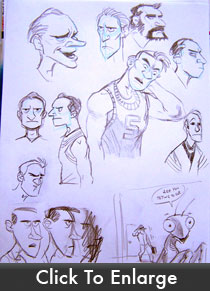
I tried certain attempts to do a lipsync for myself before. Never finished them. The problem is either that I search for a design too long (so that my motivation to animate it vanishes), or that I choose a very difficult design (that makes me struggle more with the model than the acting) and it becomes too frustrating to move on.
So this time I tried it the other way around: I started animating dummies, as you can see on my first pass.
So I could take care of the designs later. A new problem occured: I didn’t notice that the anatomic proportions of the dummies became too realistic, but originally I had a caricature in mind. Well, I didn’t care anymore, I was glad that I finished my first pass. I never got that far on my other lipsync attempts. So I moved on, and added the other details later. Sounds funny, but for the woman it was more about finding the right hairstyle. I changed the hair again on the fixed version, as you can see, because a friend told me that it was too flat and had no feeling of weight.
Do you use model sheets and turn-arounds to help you plan your animation?
Never when I do stuff for myself. One reason is because I never was good at making model-sheets and therefore it’s too much effort for only one shot. You’ll notice that the facial design of the man changes slightly during the shot. It’s not a good habit I know, because on the job you have to be professional and the characters you draw have to be consistent in their appearance.
Talk about your animation process.
I use thumbnails most of the time when I do acting shots. I enjoy exploring ideas through drawings. But sometimes I animate certain parts straight-ahead, when I know in which direction I want to go. So it’s often a combination of planning, spontaneity and failure.
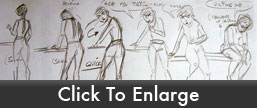
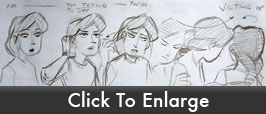
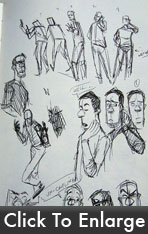
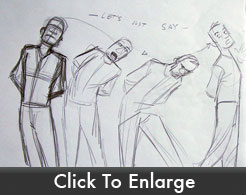
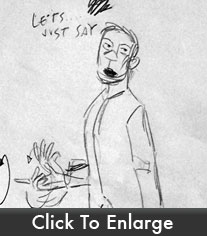
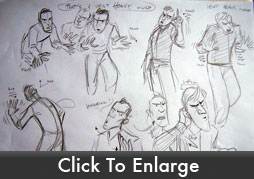
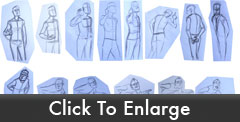
I used to film myself for reference, but it never helps me much because I can’t act it out the way I have in mind. I usually use video reference to analyze animals or if I would like to animate, for example, a baseball player. But when it comes to acting it distracts me a little bit, because my animation has to be clearer than that. It can help you with difficult angles, but a mirror will do the same trick. (If I think about it, I used the mirror a lot this time.) It would also take away the fun of exploring while animating. I need inspiration in order to create something good, if I have to work with a bad soundfile or bad design, I struggle to accomplish something acceptable. I think that’s about it.
I really like the thought-process you can see the woman go through during her line. She hardly moves at all, but you can see that she is going through several emotions in a row. How did you approach that bit of animation?
Basically my plan was to animate two characters, one with the emphasis on body language and the other one with facial expression. But she was the actual motivation for me to start this lipsync pass. I animated the guy much later. As you can see on my blocking stage (see above), I already animated the eyes roughly. I concentrated my effort in her eyes. I think she was more diffcult to animate, simply because I had such a clear vision in mind. I really knew what I wanted so I could center my whole concentration on accomplishing it. There is no ultimate secret, sometimes you just have to know exactly what your heading for and fight for it.
I think you can read it well because I reduced the movement of her head and it is so slow that you can nearly call it a “moving hold.” Readability plays a big role in succeeding with your performance. I noticed that in the contest or in the “Work in Progress" section there is no lack of great poses or good acting choices. But the problem lies often in the timing of those poses--most of the time the poses don’t get the amount of time they deserve. It also happens that there are too many (good) poses in [an 11 Second Club animator's] blocking. Even if they are great poses, sometimes you have to sacrifice certain poses for a clear idea, to keep things in balance or to get a nice rhythm in your shot.
One of the most striking things about this piece is the man's walk--the body mechanics are excellent! Talk a bit about how you approached this section in order to get the feel of weight, balance, and the man's emotion to come together.
Again this would be usually done by KeyPosing, but I did it straight ahead this time. I switch between these two techniques; if one doesn’t work I try the other one. The only thing I can say is that I’ve done a lot of walks during my jobs, so I guess it’s part of the experience that I earned. The secret of a good and solid walk is that you have to study, observe, and research from real people walking, what happens with the hips where is the weight coming from, where is it going. I heard that advice years ago, but much later I understood what it truly means: through observing.
Although I want to clearly mention that my walk is far from perfect in technical terms, not enough weight or sway, some of my colleagues already told me that. I didn’t fix that because I can live with it, it works in terms of acting. I sometimes got negative critiques because he turns around--it seems that I avoid showing his facial expressions. But him turning around was necessary, because acting isn’t defined by facial expression or arm gestures only. Every movement your character does, is a form of expression or acting, even a walk. The question is does it fit the situation. In this case he literally can’t face her and turns around (remember that I said the male part was all about body language). In the beginning of his turn he even gets into the offensive by giving him a reproachful pose with the index finger in order to underplay his shame.
Another thing: if you listen to the sound file carefully, you can hear that he is somehow turning away or walking away, so it was kind of intuitional for me to do it in this particular way. For example, in the soundfile of the February 2009 competition there is a strange, undefined sound at the end, that a few animators used to enhance their acting. You should always watch out for these tiny details even if it’s an inhale or an exhale of your character.
People either hate it or love it that [my character] turns away, but if people say “it’s a pity that we don’t see more of him,” I interpret this as a compliment.
How have your peers helped you with this scene? Did you get advice from anyone on the forums or from friends?
I sealed myself off during animation. I didn’t expect to win this competition, I wanted to see where I stand as animator. That’s why I purposely didn’t want feedback from the beginning. Later, after I “finished” and entered the competition I asked some ex-colleagues for feedback (Thanx Nic, Marcel & Chris). And after I won, I read the comments and of course the Animation Mentor eCritique. They helped me in particular with details, for example the woman, after she turned they advised me that her face should be still visible/readable, because I would be giving away some chances to show more acting of her.
Talk about a specific obstacle you struggled with while animating this piece, and how you overcame it.
I think the whole thing was an obstacle. The thing that comes into my mind is her hair and the turn, I had a lot of trouble with it. Much later I wrote a letter to my mentor to help improve it. It got better, but I’m still not satisfied with it. Right now, I don’t have the technical skills to get the results he expects. The thing that I’m most disappointed is the last pose of the man, I had to animate it during the last six hours before the competition ended. It’s weak, because I don’t think that it fits the situation or the acting I established. Right now, I have no idea how to strengthen this part, I’m working on it. I try to think of another ending for him but I wasn’t able to find time to think about it.
Talk about any new concepts you were introduced to (or re-introduced to) through the eCritique.
One thing was to put the shoulder of the man more up to strengthen the pose, when he says “Let’s just say....” 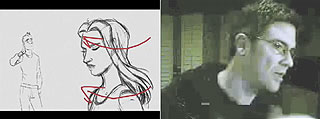 Again one of the things I didn’t include,yet.
Again one of the things I didn’t include,yet.
Another thing is the “delaying of body parts” (on the shoulders of the woman). It is a basic animation concept that I always tend to ignore when I animate, I guess out of laziness. I have to force myself to do it, I drove my supervisor crazy with it.
It’s a pity that my entry went out of sync during the last third. Unfortunately, it was a mistake which occured during rendering the movie: I rendered it out with 25 frames per second, but i originally animated it with 24 frames per second, that’s why the sound and the picture started to split at some point. (24 frames is the standard for feature films in Germany)
Do you intend to return to this piece to incorporate the suggestions made in the eCritique?
As much as possible, because constructive feedback is worth half as much, if you don’t sit down and apply those changes. But right now I managed to do only the Fixes for the woman. (Ladies first....)
Is there anything you'd like to add about your experience in January's competition?
I think I made a lot of mistakes, and because of that I feel like I learned so much during that month. More than the last 6 months together.
Sometimes you have to face a very big mountain, a real challenge. It doesn’t matter so much if you reach the top of it, as long as you feel that you improved since the last time. Well, sometimes you make big steps, but most of the time they are small steps and you have to accept that. You are allowed to accept it as long as you keep going. A lot of my favorite entries on the January competition dind’t even get into the Top 20’s. I would be lying if I said that I wouldn’t be disappointed if my entry was 24th place, but I always kept reminding myself that this competition is not supposed to be a measure of your skill, but more of a constructive mirror if your ideas communicate well, and a guide to show the areas where you can still improve.
Years ago one of the best pieces of advice I got was: “You don’t animate to impress people. You animate to move people.” That’s a major difference and something you should consider before animating.
This was your first time entering the 11 Second Club competition. Do you intend to enter again?
Of course, but it always depends on the circumstances. I would say the most important thing is that I have to fall in love with the sound file, so that I have the motivation to animate after work. But I had situations before where I deeply wanted to animate something, but my job didn’t allow it. Everybody in this buisness knows about the extra hours that this job usually claims. So it depends on several conditions.
If you had a time machine, what animation advice would you offer to Alex Petreski at the beginning of his education?
I guess nothing at all. I have seen enough time-travel movies to know that the best intentions will result into something completely different. And maybe I would end up working as a lawyer...
But seriously I would be careful with it. I worked with a lot of trainees before and I think it has a daunting effect on people who are new to this, if you tell them “you have to learn this stuff, and invest a couple of years into that, and do that first,” because it takes away the appeal and magic of this medium. To a certain degree everybody has to discover animation for themselves so that it becomes a natural passion. While I may be fascinated by the element of acting, another one could be because of the fascination of body mechanics or another one because of the joy of creating crazy characters and movements
- Alex Petreski
Discuss this interview in the forums
comments powered by Disqus






